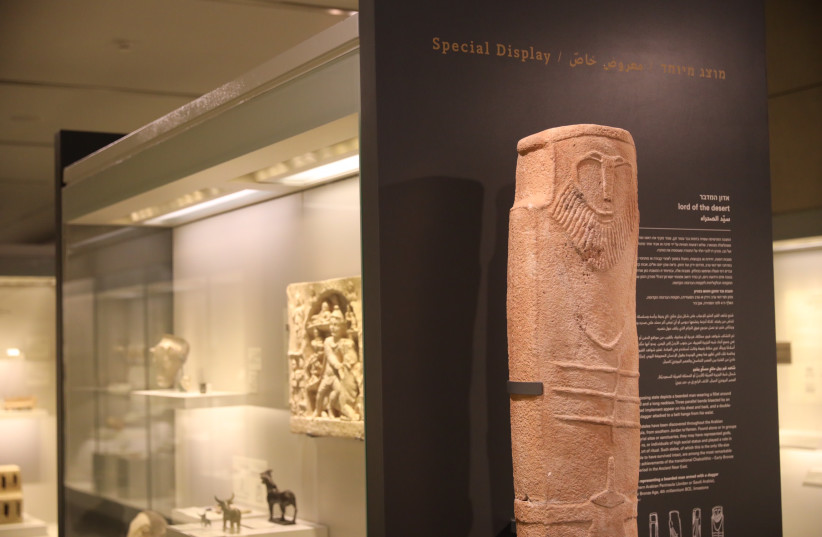Long stashed-away unknowingly in the Israel Museum’s storage rooms, a unique carved stele from the early 4th millennium BCE went on special display on March 8 at the museum.
The imposing stele – a standing relief made of a stone slab carved with figurative images – is unique not only because of its life-like size: it stands 1.74 meters high (5.7 feet) and weighs 350 kgs. (771 lbs.), but also because of its extremely well-preserved condition despite having been broken into two pieces.
Dubbed “The Lord of the Desert,” the stele was discovered in 2017 while taking inventory of the Iron Age storage area where it had been incorrectly stored since its arrival soon after the museum’s founding in 1965.
After a laborious five-year process of restoration directed by Laura A. Peri, curator of Western Asiatic Antiquities at the museum, the stele has now been put on display for the first time.
“We don’t know anything about this specific stele or how it got to the museum. We just know it was in the museum for a long time, since its founding,” Peri said. “It was a very difficult and complicated mission to restore it and put up the exhibit because it is very heavy and does not have a base so it is not stable.”

The stele depicts a bearded man wearing a band around his head, reminiscent of the agal, or cord, which holds the keffiyeh in place, and a long necklace. Three parallel cords with a long implement through them cross his chest and back. A double-bladed dagger attached to a belt hangs from his waist.
“We are really speaking of a very early and impressive, one-of-a-kind object and it is finally available for viewing by the public,” Peri said. “There is no other object like this in the world. The figurative carved images are exceptional and it is monumental in size. When they carved him they carved him on all sides and emphasized the eyes and mouth, the long necklace and the belt with the dagger.”
Dancers performing the traditional Ardah dance in Saudi Arabia and Yemen today wear this attire, including several objects depicted on the stele such as the dagger – called a jambiya, an agal, and a leather ammunition belt, Peri said.
“It is really amazing,” she said.
According to Peri’s initial research, the stele’s origin appears to be from the north Arabian Desert or south Jordan, Peri said.
Another similar but shorter stele of a bearded man which was found in El-Maakir-Qaryat al-kaafa near Ha’il, Saudi Arabia, is on exhibit at National Museum in Riyadh, Saudi Arabia, but is only one meter high (3.2 feet). The stele is broken and originally may have been as tall as the stele at the Israel Museum, Peri said.
“We want to continue the research and analyze the stone of our stele to try and determine where it came from exactly,” she added.
Other steles like this have been discovered from south Jordan to Yemen but most of these are either broken or the carvings are not so well preserved, Peri said. Steles have been found alone or in groups near burial sites or sanctuaries.
They may have represented gods, ancestors, or individuals of high social status and been used as a gravestone or played a role in rituals, she said. Because no written text from that period is available to substantiate any theories of their purpose, scholars can only guess based on later traditions, she added.
In later civilizations, steles were used to emphasize boundaries by kings declaring their conquest over land, or they were placed in temples as images of god, she said.
Interestingly, Peri said, similar steles from the same period have also been found ranging from the Iberian Peninsula to the Caucasus, and though they are not full anthropomorphic figures, they do have similar details such as the dagger and a face of a bearded man.
“The dagger was a very important element,” she said.
The Lord of the Desert stele is now on display opposite another stele from the second half of the 8th century BCE of the founder of the Assyrian Empire, King Tiglath-Pileser III, which has an inscription paying tribute to Menachem, son of Gadi, King of Israel.
